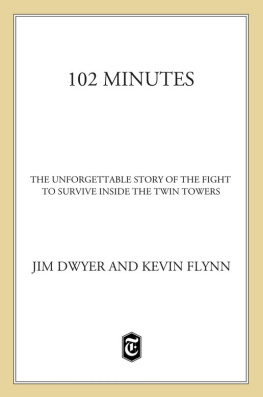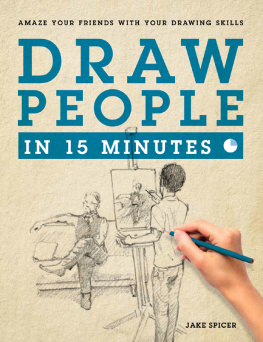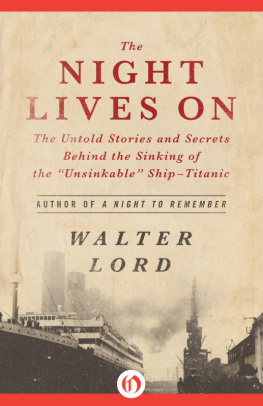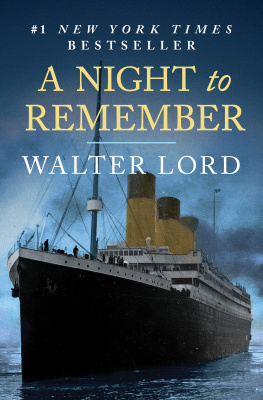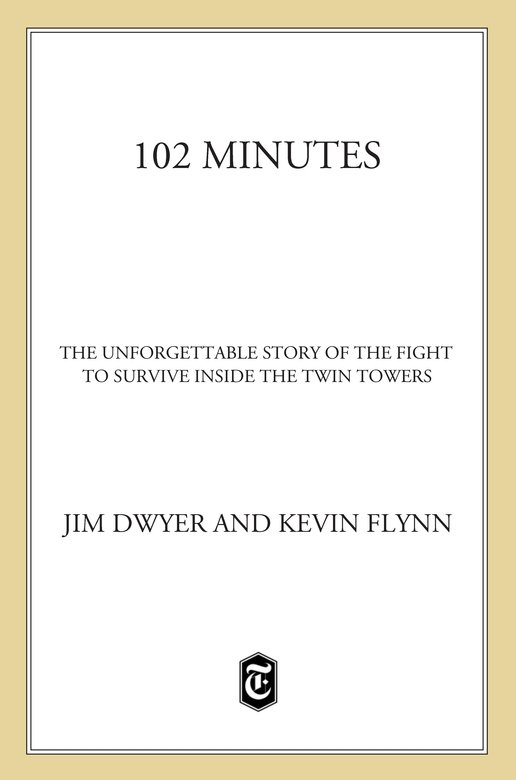This work was supported and guided by a cast of hundredsby people who escaped the buildings, family members of those lost at the trade center, our colleagues at The New York Times and other newspapers, the editorial staff in the Times Books division of Henry Holt and Company, many past and present public servants, interested citizens, friends, and our own families. In the fabric of September 11, there are many to mourn and much to admire; we regret that we could recount only a fraction of the days struggles in these pages. We are grateful to all who told us of what they saw, heard, and did.
Scores of people provided voice mails, e-mails, and their recollections of conversations with loved ones inside the trade center and trapped on the upper floors. Many families were insistent that the history be told straight. We thank Nicole De Martini, Nina De Martini, Rosemary De Martini, and other members of the De Martini family, Debbie Palmer, Edna Kang Ortiz, Sally and Al Regenhard, Monica Gabrielle, Beverly Eckert, Jimmy Boyle, Iliana McGinnis, Steve and Liz Alderman, Beth Tipperman, Irma Fuller, the Eng family, the Olender family, Maureen Paglia, Lori Kane, Rita Palacios, Glenn Voght, Jim Smith, George and Mary Andrucki, Lynn Udbjorg, Dennis Kelly, Tommy Patchel, Michael and Peg Meehan and their family, Ann Johnson, Maureen Foo-Van Natten, Bernie Heeran, Jill Rosenblum, Arline Nussbaum, the Beyea family, the Zelmanowitz family, Judy Feeney, Colleen Kelly, Maureen Donegan, Peter Mulderry, Dorry Tompsett, Laurie Carter, Mary Maciejewski,Marion Biegeleisen, Elizabeth Mattson, Linda Perry Thorpe, Mary Fetchet, Kimmy Chedel, Corine Mardikian, Jessica Carucci, Vinny Camaj, Patricia Perry, Cristy Ferer.
In early 2002, a team of reporters at the Times traced the events on the upper floors of the towers and aspects of the emergency response. We drew on that research for this book, and on the insights of Ford Fessenden, James Glanz, and Eric Lipton. We were honored to share bylines with them. Anyone interested in the history of late twentiethcentury New York City can turn to City in the Sky, a masterful account of the trade centers rise and fall written by Jim and Eric. Ford and Eric helped create a framework for cataloging the research, and it has stood up well, thanks to a database designed by Tom Torok. It has been an essential and durable tool in piecing together a narrative from thousands of fragments of information. Others who worked with us on the initial newspaper projects or provided essential veins of research for this book include Alain Delaqueriere, Michelle ODonnell, Michael Pollak, Lauren Wolfe, Joseph Plambeck, David Dunlap, Ian Urbina, Leslie Eaton, and Aron Pilhoffer. They have our thanks.
With careful reporting and illuminating artwork, visual journalists at the Times Steve Duenes, Archie Tse, Mika Grndahl, and James Bronzancaptured both the shape of the moment and the form of the buildings. We are especially grateful to Steve, who refined the graphics for this book.
Joe Sexton, editor and friend, read all the documents and tracked each sentence in our newspaper stories; we are better in every way because of him, his passion, his demanding intelligence, and the occasional late-hour refreshments. Paul Golob, the editorial director of Times Books, edited this manuscript with great vigor, rigor, and clarity; any writer would be fortunate indeed to have Pauls sharp eyes on the page and wise hands around the book.
Over a period of three years, two metropolitan editors at the Times, Jon Landman and Susan Edgerley, made sure that these stones were told. We could not ask for better bosses.
This work began with the unbridled support of Howell Raines and Gerald Boyd, then executive editor and managing editor of the Times, and continued with similar backing from their successors, Bill Keller, Jill Abramson, and John Geddes. John Sterling, president and publisher of Henry Holt and Company, provided critical early guidance and support. The former editorial director of book development at the Times, Susan Chira, championed this book when it was only a couple of sentences, mumbled across a cup of coffee, and continued her efforts until she took over the world as the newspapers foreign editor; her successor, Alex Ward, contributed keen observations about the manuscript and marshaled graphics and many of the pictures that appear in these pages. We thank, as well, Bill Schmidt and Jennifer Preston, for their assistance.
A number of public officials believed that the history of the day, as recorded in city records, belonged in the public domain, and used informal channels to make vital material available to us. We thank them by not naming them in these pages.
In federal and state courts in New York, New Jersey, and Virginia, David McCraw, New York Times counsel, has been a resourceful, principled, and determined advocate for access to public records concerning September 11. Among other things, his advocacy led to the release of the sole radio recording of firefighters inside either building, a tape that not even the Fire Department had listened to until David argued that it was a public record whose release would not jeopardize any fights against terrorism. From it emerged the account of Orio Palmers race to the 78th floor of the south tower, and important revelations about the working of the radio system. David was assisted in New Jersey by another diligent lawyer, Bruce Rosen of McCusker, Anselmi, Rosen, Carvelli & Walsh, who brought an action in Superior Court that ultimately forced the Port Authority to release 2,000 pages of radio transcripts and police memoranda. In addition, Norman Siegel, a civil rights attorney in New York acting on behalf of a group of people lost at the trade center, has also been a determined advocate for the release of public records.
Paul Ginsberg, the president of Professional Audio Laboratories, enhanced certain Port Authority tape recordings and significantly improved the reliability of the transcript.
Others who played key roles in getting this book ready areMichael Pollak, Brianna Smith, Robin Dennis, and Rita Quintas. We thank our agent and friend, Flip Brophy, and her assistant, Cia Glover, and for legal advice, Louise Sommers.
At the Port Authority of New York and New Jersey, important information about the buildings and the events of the day was provided by Alan Reiss and Mike Hurley. We were also assisted by Greg Trevor, Allen Morrison, Peter Yerkes, Kevin Davitt, Steve Coleman, Frank Lombardi, and Christopher Hartwyk. We also thank Patricia Cullen, Mak Hannah, Gerry Gaeta, Gerry Drohan, George Phoenix, Shivam Iyer, Anthony Whitaker, Al DeVona, David Lim.
We thank John Auletta of Summit Security, along with John Nolan, James Flores, and Greg Trapp.
Among those who provided information about their experiences inside the trade center are Brian Clark, Dianne DeFontes, Tirsa Moya, Walter Pilipiak, Michael Sheehan, Jan Demczur, Al Smith, Tim Pearson, Joseph Baccellieri, Will Jimeno, Dave Karnes, Chuck Sereika, and Sharon Premoli. Many other people who also were generous with their time and recollections are cited in the notes section. In particular, Roberta Gordon, an attorney and friend of Frank De Martinis family, shared with us a thoroughly researched profile of De Martini and a moving narrative of his actions. We are very grateful.
We received help on technical issues from many experts, including Nicholas Grecco, the retired chief engineer of the New York City Department of Buildings; Glenn Corbett, professor of fire safety at John Jay College of Criminal Justice of the City University of New York; retired fire chiefs Vincent Dunne, Charles Blaich, Bernard Lally, and retired firefighter and author Dennis Smith; John McFadden of Motorola and New York radio expert Eric Lustig; Greg Semendinger, a retired NYPD pilot; former officials with the citys Office of Emergency Management, Frank McCarton, Richard Sheirer, and Jerome Hauer; the current building commissioner, Patricia J. Lancaster, the buildings department spokeswoman, Ilyse Fink, and former building commissioner Rudolph Rinaldi; on the 911 system from Gino Menchini; Charles Brecher of the Citizens Budget Commission; on evacuation issues, Jake Pauls and Robyn Gershon; Won-Young Kim of the Lamont-DohertyEarth Observatory of Columbia University; Shyam Sunder and Michael Newman of the National Institute of Standards and Technology; and Jack J. Murphy of the Fire Safety Directors Association. We also thank George Taylor, Bernie Patton, Martin J. Steadman, and Darlene Dwyer for their assistance.

